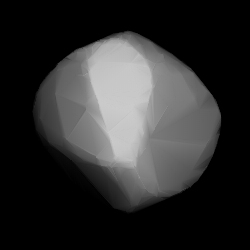Astronomy:176 Iduna
 3D convex shape model of 176 Iduna | |
| Discovery | |
|---|---|
| Discovered by | C. H. F. Peters |
| Discovery date | 14 October 1877 |
| Designations | |
| (176) Iduna | |
| Pronunciation | /iːˈduːnə/ |
| Named after | Iðunn |
| A877 TB; 1945 RQ | |
| Minor planet category | Main belt |
| Orbital characteristics[1] | |
| Epoch 31 July 2016 (JD 2457600.5) | |
| Uncertainty parameter 0 | |
| Observation arc | 138.50 yr (50587 d) |
| |{{{apsis}}}|helion}} | 3.7235 astronomical unit|AU (557.03 Gm) |
| |{{{apsis}}}|helion}} | 2.6526 AU (396.82 Gm) |
| 3.1880 AU (476.92 Gm) | |
| Eccentricity | 0.16796 |
| Orbital period | 5.69 yr (2079.1 d) |
| Mean anomaly | 165.15° |
| Mean motion | 0° 10m 23.34s / day |
| Inclination | 22.660° |
| Longitude of ascending node | 200.50° |
| 188.17° | |
| Earth MOID | 1.65682 AU (247.857 Gm) |
| Jupiter MOID | 1.73015 AU (258.827 Gm) |
| TJupiter | 3.056 |
| Physical characteristics | |
| Dimensions | 121.04±2.2 km |
| Rotation period | 11.2877 h (0.47032 d)[1] 11.289 hours[2] |
| Geometric albedo | 0.0834±0.003 |
| G | |
| Absolute magnitude (H) | 8.2 |
Iduna (minor planet designation: 176 Iduna) is a large main-belt asteroid that was discovered by German-American astronomer Christian Heinrich Friedrich Peters on October 14, 1877, in Clinton, New York. It is named after Sällskapet Idun, a club in Stockholm that hosted an astronomical conference; Idun (Iðunn, Iduna) is also a Norse goddess.[3][4] A G-type asteroid, it has a composition similar to that of the largest main-belt asteroid, 1 Ceres.
An occultation of a star by Iduna was observed from Mexico on January 17, 1998.
Photometric observations of this asteroid at the Romer Observatory in Aarhus, Denmark during 1996 gave a light curve with a period of 11.289 ± 0.006 hours and a brightness variation of 0.35 in magnitude.[2] A 2008 study at the Palmer Divide Observatory in Colorado Springs, Colorado gave a period of 11.309 ± 0.005 hours, confirming the 1996 result.[5]
References
- ↑ 1.0 1.1 Yeomans, Donald K., "176 Iduna", JPL Small-Body Database Browser (NASA Jet Propulsion Laboratory), https://ssd.jpl.nasa.gov/sbdb.cgi?sstr=176, retrieved 12 May 2016.
- ↑ 2.0 2.1 Hansen, A. T.; Arentoft, T. (June 1997), "The Rotational Period of 176 Iduna", The Minor Planet Bulletin 24: 14, Bibcode: 1997MPBu...24Q..14H.
- ↑ "Motiveringar till asteroidnamn med svensk anknytning." (in Swedish). Uppsala University. http://www.astro.uu.se/~classe/svenska_ast-K081215.html.
- ↑ Schmadel, Lutz (1992). Dictionary of Minor Planet Names. 2. Berlin: Springer Verlag. p. 28. ISBN 3-540-00238-3. https://books.google.com/books?id=aeAg1X7afOoC&q=176+Iduna&pg=PA28. Retrieved 24 October 2017.
- ↑ Warner, Brian D. (June 2008), "Asteroid Lightcurve Analysis at the Palmer Divide Observatory - June - October 2007", The Minor Planet Bulletin 35 (2): 56–60, Bibcode: 2008MPBu...35...56W.
External links
- Lightcurve plot of 176 Iduna, Palmer Divide Observatory, B. D. Warner (2007)
- Asteroid Lightcurve Database (LCDB), query form (info )
- Dictionary of Minor Planet Names, Google books
- Asteroids and comets rotation curves, CdR – Observatoire de Genève, Raoul Behrend
- Discovery Circumstances: Numbered Minor Planets (1)-(5000) – Minor Planet Center
- 176 Iduna at AstDyS-2, Asteroids—Dynamic Site
- 176 Iduna at the JPL Small-Body Database
 |

